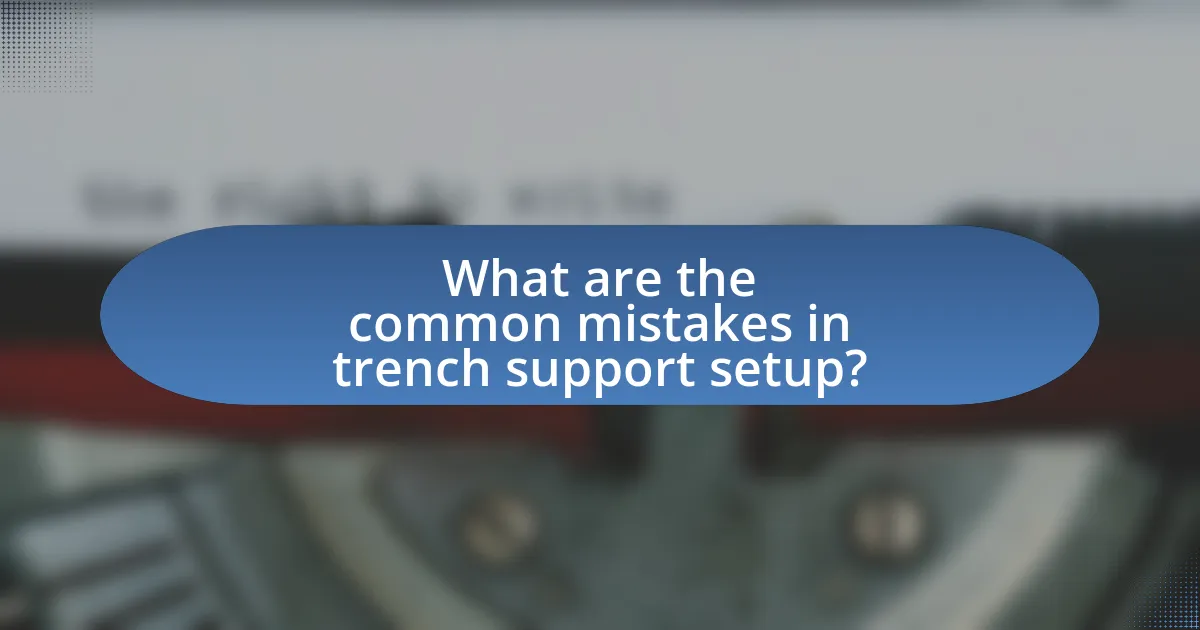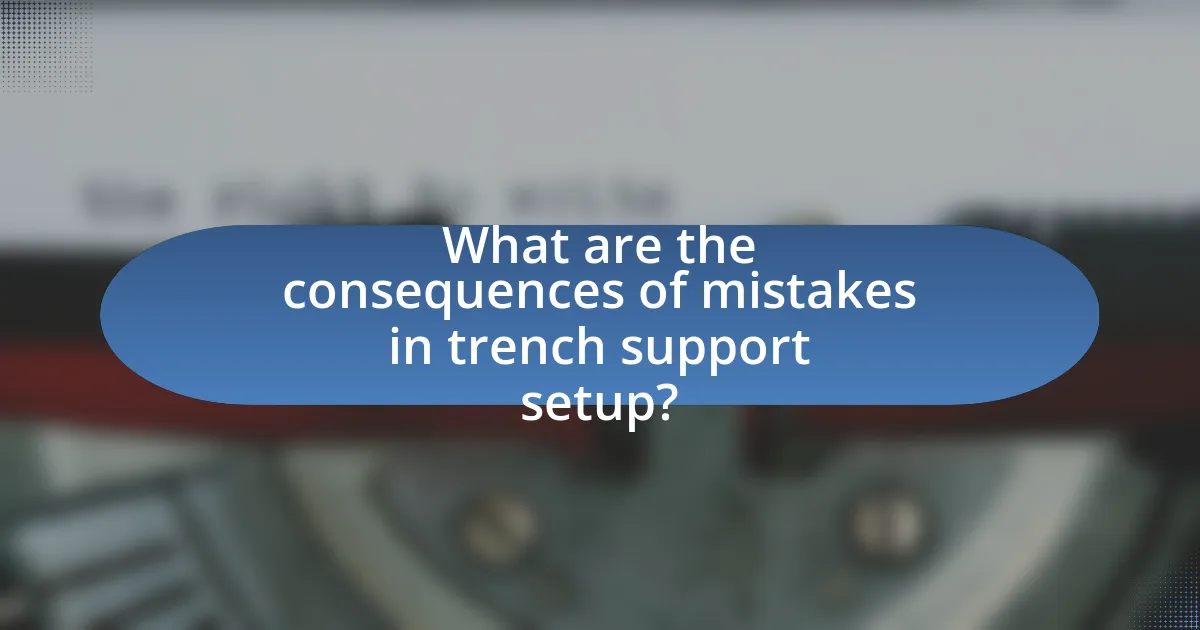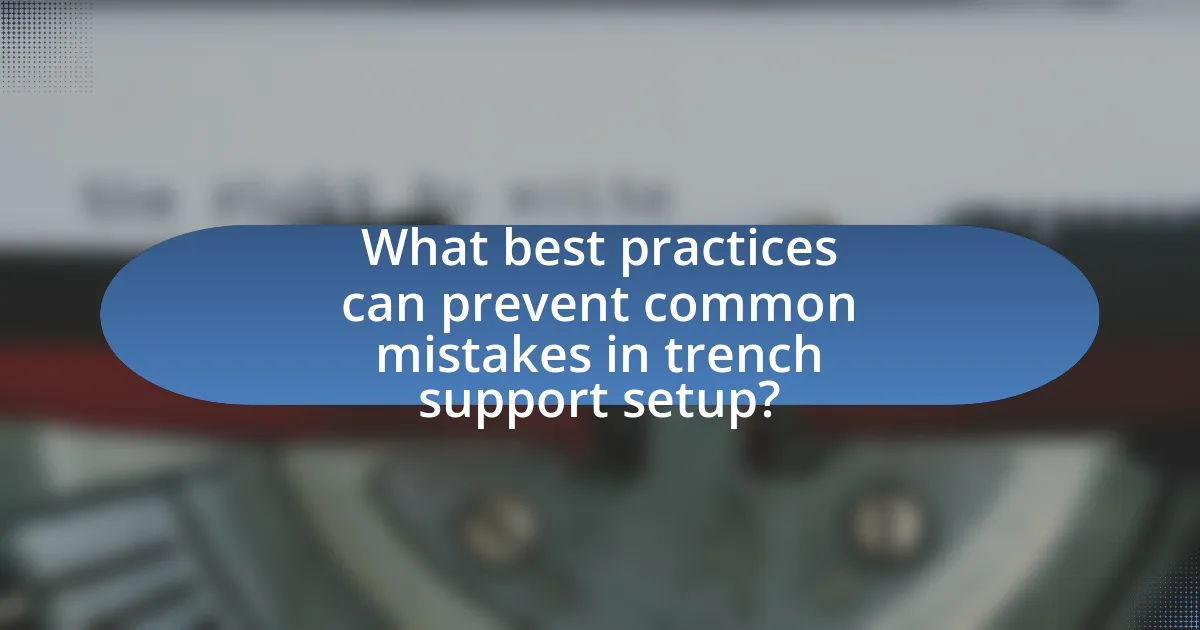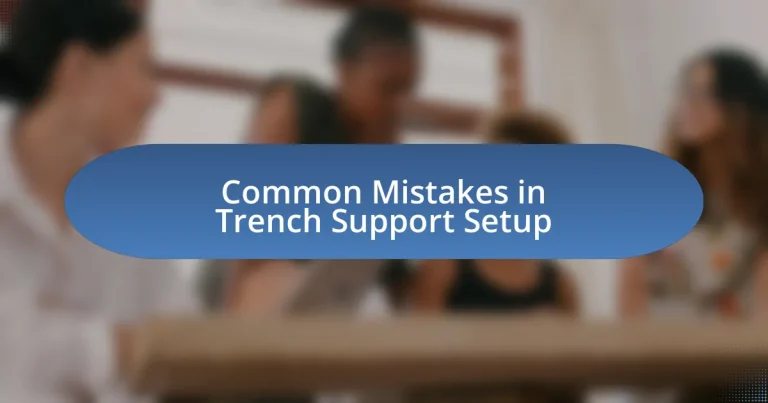The article focuses on common mistakes in trench support setup, emphasizing the critical importance of proper safety measures to prevent accidents and injuries. Key errors include inadequate shoring, improper spacing of supports, and failure to assess soil conditions, all of which can lead to trench collapses and serious hazards for workers. The article highlights the role of regulations, training, and effective communication in mitigating these risks, as well as the financial and legal ramifications of trench support failures. Additionally, it discusses best practices and technological advancements that can enhance trench safety and ensure compliance with safety standards.

What are the common mistakes in trench support setup?
Common mistakes in trench support setup include inadequate shoring, improper spacing of supports, and failure to account for soil conditions. Inadequate shoring can lead to trench collapses, as supports may not provide sufficient resistance against lateral earth pressures. Improper spacing of supports can compromise the structural integrity of the trench, increasing the risk of failure. Additionally, neglecting to assess soil conditions, such as moisture content and type, can result in unexpected instability, as different soils behave differently under load. These mistakes highlight the importance of following established safety guidelines and conducting thorough site assessments to ensure effective trench support.
Why is proper trench support setup crucial for safety?
Proper trench support setup is crucial for safety because it prevents collapses that can lead to serious injuries or fatalities. Trench collapses occur frequently, with the Occupational Safety and Health Administration (OSHA) reporting that they account for approximately 25% of all excavation-related fatalities. Adequate support systems, such as trench boxes or shoring, are designed to withstand the forces exerted by surrounding soil, thereby protecting workers from being buried or trapped. Implementing proper trench support not only complies with safety regulations but also significantly reduces the risk of accidents, ensuring a safer work environment.
What are the potential hazards of inadequate trench support?
Inadequate trench support can lead to serious hazards, including trench collapses, which pose significant risks to workers’ safety. When trenches lack proper support systems, the soil can become unstable, resulting in cave-ins that can bury workers under heavy loads. According to the Occupational Safety and Health Administration (OSHA), trench collapses account for approximately 75 fatalities annually in the United States, highlighting the critical nature of proper trench support. Additionally, inadequate support can lead to falls, equipment accidents, and exposure to hazardous materials, further endangering workers.
How can improper setup lead to accidents or injuries?
Improper setup can lead to accidents or injuries by creating unstable conditions that increase the risk of trench collapses. When trench support systems are not correctly installed, they may fail to adequately hold back the surrounding soil, resulting in cave-ins that can bury workers. According to the Occupational Safety and Health Administration (OSHA), trench collapses can occur within seconds, and the weight of the soil can exert forces of up to 3,000 pounds per cubic yard, making it critical to follow proper setup protocols. Additionally, inadequate shoring or bracing can compromise the integrity of the trench, leading to falls or equipment accidents, further emphasizing the importance of correct setup in preventing serious injuries.
What are the most frequently observed mistakes in trench support setup?
The most frequently observed mistakes in trench support setup include inadequate bracing, improper installation of support systems, and failure to assess soil conditions. Inadequate bracing can lead to trench collapse, as it does not provide sufficient lateral support. Improper installation of support systems, such as not following manufacturer guidelines, compromises the integrity of the setup. Additionally, failure to assess soil conditions can result in selecting inappropriate support methods, increasing the risk of accidents. These mistakes are critical as they directly impact worker safety and compliance with regulations, such as those outlined by the Occupational Safety and Health Administration (OSHA), which mandates specific requirements for trench safety.
How does failing to assess soil conditions impact trench support?
Failing to assess soil conditions significantly compromises trench support, leading to increased risks of collapse. Soil type, moisture content, and compaction directly influence the stability of trench walls; without proper evaluation, inadequate support systems may be implemented. For instance, sandy or loose soils require different support measures compared to cohesive clays. According to the Occupational Safety and Health Administration (OSHA), approximately 75% of trench-related fatalities occur due to collapses, often linked to improper soil assessment. Therefore, neglecting soil evaluation can result in unsafe working environments and severe accidents.
What role does equipment selection play in trench support errors?
Equipment selection is critical in preventing trench support errors, as the wrong equipment can lead to inadequate support and increased risk of collapse. For instance, using equipment that is not rated for the specific soil conditions or trench depth can compromise stability, resulting in accidents. Studies indicate that improper equipment choice is a leading factor in trench-related incidents, with the Occupational Safety and Health Administration (OSHA) reporting that over 60% of trench collapses occur due to inadequate support systems. Therefore, selecting appropriate equipment tailored to the specific environmental and structural conditions is essential for ensuring safety and compliance in trench support setups.
How can miscommunication contribute to trench support mistakes?
Miscommunication can significantly contribute to trench support mistakes by leading to incorrect interpretations of safety protocols and structural requirements. When team members fail to clearly convey or understand instructions regarding trench dimensions, support placement, or material specifications, it increases the risk of inadequate support systems. For instance, a study by the Occupational Safety and Health Administration (OSHA) indicates that improper communication about trench safety can result in collapses, which are responsible for numerous fatalities and injuries in construction. This highlights that clear and precise communication is essential to ensure that all personnel are aligned on safety measures and construction practices, thereby reducing the likelihood of errors in trench support setups.
What are the common communication breakdowns on job sites?
Common communication breakdowns on job sites include unclear instructions, lack of feedback, and misinterpretation of safety protocols. Unclear instructions can lead to workers misunderstanding their tasks, resulting in errors and inefficiencies. Lack of feedback prevents team members from addressing issues promptly, which can exacerbate problems. Misinterpretation of safety protocols can lead to dangerous situations, as workers may not fully understand the necessary precautions. These breakdowns can significantly impact project timelines and worker safety, highlighting the importance of effective communication strategies in construction environments.
How can clear instructions prevent trench support errors?
Clear instructions can prevent trench support errors by ensuring that all personnel understand the correct procedures and safety measures required for effective trench support. When workers receive detailed guidelines on installation, maintenance, and inspection of trench supports, they are less likely to make mistakes that could lead to collapses or accidents. For instance, a study by the Occupational Safety and Health Administration (OSHA) indicates that clear communication and training significantly reduce the risk of trench-related incidents, which accounted for 23% of construction fatalities in the United States in recent years. By following precise instructions, workers can adhere to safety protocols, thereby minimizing the likelihood of errors in trench support setups.

What are the consequences of mistakes in trench support setup?
Mistakes in trench support setup can lead to severe consequences, including structural failure, worker injuries, and increased project costs. Structural failure occurs when inadequate support systems are employed, resulting in trench collapses that can bury workers and equipment. According to the Occupational Safety and Health Administration (OSHA), trench collapses account for approximately 25% of excavation-related fatalities. Worker injuries can range from minor to life-threatening, with incidents often leading to long-term disability or loss of life. Additionally, mistakes can cause project delays and financial losses due to the need for rework, legal liabilities, and potential fines from regulatory bodies. These factors underscore the critical importance of proper trench support setup to ensure safety and project efficiency.
How do mistakes affect project timelines and costs?
Mistakes in trench support setup significantly delay project timelines and increase costs. When errors occur, such as improper installation or inadequate safety measures, projects often face rework, which can extend the duration of the project by weeks or even months. For instance, a study by the Construction Industry Institute found that rework can account for 5-20% of total project costs, directly impacting budgets. Additionally, delays caused by mistakes can lead to increased labor costs and potential penalties for late completion, further inflating overall expenses.
What are the financial implications of trench support failures?
Trench support failures can lead to significant financial implications, including increased project costs, legal liabilities, and potential fines. When trench support systems fail, projects may experience delays due to necessary repairs or redesigns, which can escalate labor and material expenses. For instance, the Occupational Safety and Health Administration (OSHA) reported that trench collapses can cost companies thousands of dollars in fines and legal fees, as well as lost productivity. Additionally, injuries or fatalities resulting from trench failures can lead to compensation claims and higher insurance premiums, further straining financial resources.
How can delays from mistakes impact overall project success?
Delays from mistakes can significantly hinder overall project success by extending timelines and increasing costs. When errors occur in trench support setup, they can lead to safety incidents, necessitating additional time for corrections and inspections. For instance, a study by the Construction Industry Institute found that project delays can increase costs by up to 20% for every week of delay. Furthermore, these setbacks can disrupt resource allocation and scheduling, leading to a cascading effect on subsequent project phases. Ultimately, the cumulative impact of these delays can jeopardize project completion, stakeholder satisfaction, and profitability.
What legal ramifications can arise from trench support errors?
Trench support errors can lead to significant legal ramifications, including liability for injuries or fatalities that occur due to collapses. When trench support systems fail, employers may face lawsuits from injured workers or their families, as well as potential fines from regulatory bodies such as the Occupational Safety and Health Administration (OSHA). For instance, OSHA mandates compliance with safety standards, and failure to adhere to these regulations can result in citations and penalties, which can escalate to criminal charges if negligence is proven. Additionally, insurance claims may be denied if the trench support was improperly installed, further complicating the legal landscape for the responsible parties.
How do regulations influence trench support practices?
Regulations significantly influence trench support practices by establishing safety standards and guidelines that must be followed to prevent accidents and ensure worker safety. These regulations, such as those set by the Occupational Safety and Health Administration (OSHA), mandate specific requirements for trench depth, width, and the type of support systems to be used, thereby shaping the methods employed in trench construction. For instance, OSHA’s standards require that trenches deeper than five feet be protected against cave-ins, which directly impacts the choice of support systems like trench boxes or shoring. Compliance with these regulations not only minimizes the risk of injuries but also enforces accountability among contractors, ensuring that proper safety measures are implemented during excavation activities.
What are the potential liabilities for companies involved in trench accidents?
Companies involved in trench accidents may face significant liabilities, including legal claims for negligence, workers’ compensation claims, and potential fines from regulatory agencies. Negligence arises when a company fails to adhere to safety standards, leading to accidents that cause injury or death. For instance, the Occupational Safety and Health Administration (OSHA) mandates specific safety protocols for trenching operations; failure to comply can result in citations and financial penalties. Additionally, if an employee is injured, the company may be liable for medical expenses and lost wages under workers’ compensation laws. Historical data indicates that trench collapses are a leading cause of construction fatalities, emphasizing the importance of proper safety measures and the potential financial repercussions for companies that neglect them.

What best practices can prevent common mistakes in trench support setup?
To prevent common mistakes in trench support setup, implementing proper planning and adherence to safety regulations is essential. Conducting a thorough site assessment before excavation helps identify soil conditions and potential hazards, which informs the selection of appropriate support systems. Additionally, following guidelines from organizations such as OSHA, which mandates specific trench safety measures, ensures compliance and reduces risks. Regular training for workers on trench safety protocols further minimizes errors, as informed personnel are less likely to overlook critical safety measures.
How can proper training reduce the risk of errors?
Proper training significantly reduces the risk of errors by equipping individuals with the necessary skills and knowledge to perform tasks accurately. When workers receive comprehensive training on trench support setup, they learn about safety protocols, equipment usage, and potential hazards, which directly minimizes the likelihood of mistakes. For instance, a study by the National Institute for Occupational Safety and Health (NIOSH) found that proper training can decrease the incidence of accidents in construction by up to 30%. This evidence underscores the importance of training in fostering a safer work environment and enhancing overall operational efficiency.
What key topics should be included in trench support training programs?
Key topics that should be included in trench support training programs are soil analysis, trench design principles, support systems, safety protocols, and emergency response procedures. Soil analysis is crucial as it determines the type of support needed based on soil composition and stability. Trench design principles cover the dimensions and configurations necessary to prevent collapses. Support systems include various methods such as shoring and shielding to maintain trench integrity. Safety protocols address the use of personal protective equipment and hazard recognition. Emergency response procedures prepare workers for potential accidents or collapses, ensuring quick and effective action. These topics are essential for minimizing risks and ensuring worker safety in trench operations.
How often should training be updated to reflect current standards?
Training should be updated at least annually to reflect current standards. This frequency ensures that the training content remains relevant and incorporates the latest safety regulations, industry best practices, and technological advancements. Regular updates are essential, as standards can change due to new research findings, regulatory changes, or advancements in trench support technology, which can significantly impact safety and effectiveness in trench support setups.
What tools and technologies can enhance trench support safety?
Tools and technologies that can enhance trench support safety include trench boxes, hydraulic shoring systems, and monitoring sensors. Trench boxes provide a protective barrier that prevents soil collapse, while hydraulic shoring systems offer adjustable support to stabilize trench walls. Monitoring sensors can detect soil movement and environmental changes, alerting workers to potential hazards. According to the Occupational Safety and Health Administration (OSHA), proper use of these tools significantly reduces the risk of trench-related accidents, which account for approximately 100 fatalities annually in the United States.
How can monitoring equipment improve trench safety?
Monitoring equipment can significantly improve trench safety by providing real-time data on environmental conditions and structural integrity. This technology enables early detection of potential hazards such as soil movement, water accumulation, or gas leaks, which can lead to trench collapses. For instance, sensors can monitor soil pressure and moisture levels, alerting workers to unsafe conditions before they become critical. Studies have shown that implementing monitoring systems can reduce trench-related accidents by up to 50%, highlighting their effectiveness in enhancing safety protocols.
What role does technology play in assessing trench conditions?
Technology plays a crucial role in assessing trench conditions by providing real-time data and analysis that enhance safety and efficiency. Advanced tools such as ground-penetrating radar (GPR) and laser scanning allow for precise mapping of subsurface conditions, identifying potential hazards like voids or unstable soil layers. For instance, studies have shown that using GPR can reduce the risk of trench collapses by up to 30% by enabling better planning and risk assessment before excavation begins. Additionally, remote monitoring systems can track soil movement and moisture levels, allowing for timely interventions to prevent accidents.
What are some practical tips for ensuring effective trench support setup?
To ensure effective trench support setup, implement proper shoring techniques and regularly inspect the trench for stability. Utilizing materials such as hydraulic shoring or trench boxes can provide necessary support against soil collapse. According to OSHA regulations, trenches deeper than five feet require protective systems to prevent cave-ins, which are a leading cause of fatalities in excavation work. Regular monitoring of soil conditions and weather impacts is essential, as wet or unstable soil can significantly increase the risk of trench failure.


